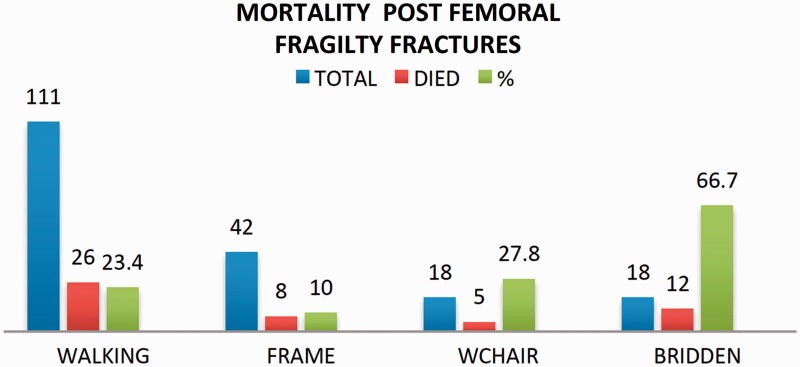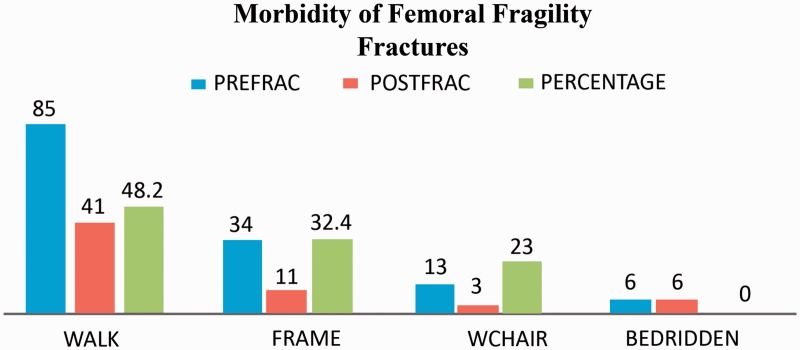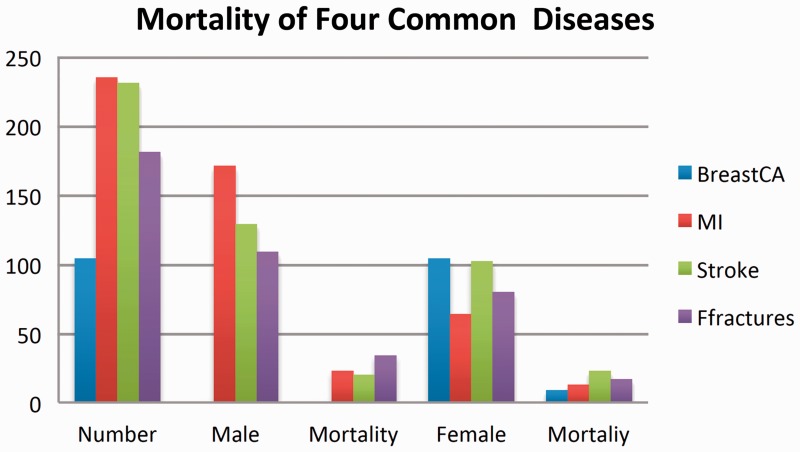Abstract
Objective
To determine the functional morbidity and mortality after fragility hip fracture and compare the mortality with three other common diseases.
Methods
Data were collected from patients admitted to King Fahd Hospital of the University, AlKhobar from January 2010 to December 2014. Demographic data included the preoperative American Society of Anesthesiologists (ASA) score as assessed by the anesthetist and the type of surgery. Personal and telephone interviews were performed, and data were entered into a database and analyzed.
Results
We identified 203 patients with fragility proximal femoral fractures, and the data of 189 patients (109 male, 80 female; average age, 66.90 ± 13.43 years) were available for analysis. The overall mortality rate was 26.98% (51 patients). The mortality rate was significantly higher among patients with an ASA score of 4 (36.36%) than 1 (20.45%). With respect to morbidity, only 48.23% of patients were able to return to their pre-fracture status; 32.35% of those who required assisted walking and 83.4% of those who required a wheelchair became bedridden.
Conclusions
Our data demonstrate that patients with fragility hip fractures have high morbidity and a mortality rate approaching 30%. Age and the ASA score significantly influence this high mortality rate.
Keywords: Osteoporosis, fragility fracture, femoral fracture, morbidity, mortality
Introduction
Osteoporosis is common in the Saudi Arabian population, and its reported prevalence is >30% in men and women aged ≥56 years.1,2 Fragility fractures, particularly of the proximal femur, may have serious consequences including early death or decreased functional mobility,3 ultimately affecting the patient’s quality of life.4 From 2015 to 2025 in the United States, fragility hip fractures are expected to increase by an estimated 26%,5 and this will further increase the incidence of temporary and permanent morbidity and disability.6,7 A recent study revealed that the incidence of proximal femoral fractures in a Saudi population of patients aged ≥50 years was 5.89/1000.8 Very high mortality rates associated with fragility hip fractures have been reported in developed countries, with 5% to 10% of affecting patients dying within 1 month of fracture and 20% to 30% dying within 1 year.9,10 In 2013, Diamantopoulos et al.11 reported a 1-year overall mortality rate of 21.3% (males, 30.7%; females, 19.1%), whereas in 2011, Castronuovo et al.12 reported an overall mortality rate of 26% (females, 23%; males, 37%) during a median follow-up time of 15.8 months (range, 1 day to 2 years).
The economic burden of these fractures is high; approximately one-third of affected patients are sent to nursing homes and long-term care hospitals. Such facilities are not available in Saudi Arabia; hence, fragility femoral fractures place a tremendous social burden on families and hospitals. Considering these circumstances, every effort should be made to reduce the incidence of such fractures.
Few data on fragility femoral fracture are available in Saudi Arabia; thus, only one study has reported the mortality rate after such fractures.13 The present study was performed to evaluate the mortality and functional morbidity after fragility proximal femoral fracture and compare the hospital-based mortality after femoral fracture with that of breast cancer, stroke, and myocardial infarction at King Fahd Hospital of the University, AlKhobar, Saudi Arabia.
Methods
This retrospective analysis was conducted after approval by the institutional review board of Imam AbdulRahman Bin Faisal University, Dammam and King Fahd Hospital of the University. King Fahd Hospital of the University is a tertiary care center serving an area of 4 million people and directly receives trauma patients. From January 2010 to December 2014, data of patients with fragility proximal femoral fractures admitted to King Fahd Hospital of the University, AlKhobar were collected from the QuadruMed hospital database and cross-checked with admission and discharge data from the male, female, and intensive care wards and the operating room. The data collected were age, sex, nature of the injury, side of the injury, pre-fracture status, preoperative American Society of Anesthesiologists (ASA) score as assessed by the anesthetist, and type of surgery.
Data regarding the mortality of patients with breast cancer, myocardial infarction, and cerebrovascular accident were collected for the same time period. The members of the investigative team who entered the data into the database for analysis also carried out personal and telephone interviews. The data were analyzed using the Statistical Package for the Social Sciences, version 19.0 (IBM Corp., Armonk, NY, USA). Continuous variables are presented as mean and standard deviation, and categorical variables are presented as number and percentage. Means were tested using Student’s t test and percentages were tested using the chi-square test. A P value of <0.05 was considered statistically significant.
Results
We identified 203 patients with fragility proximal femoral fractures during the study period, and the data of 189 patients were available for analysis. The average age was 66.90 ± 13.43 years, and 109 (57.7%) patients were male and 80 (42.3%) were female. The average age of the male patients was 64.93 ± 11.72 years, and that of the female patients was 69.02 ± 14.33 years (P < 0.0036; 95% confidence interval, −6.7802 < −1.3998). The minimum follow-up duration was 24 months. The overall mortality rate was 26.98% (51 patients). The mortality rate was significantly higher among patients with an ASA score of 4 (36.36%) than those with an ASA score of 1 (20.45%) (P < 0.001). The patients were divided into four groups: Group I, normal walking (n = 111, 58.73%); Group II, assisted walking (cane or frame) (n = 42, 22.22%); Group III, wheelchair-bound (n = 16, 8.46%); and Group IV, bedridden (n = 18, 9.52%). The numbers of patients in Groups I, II, III, and IV who died within the first 12 months were 26 (23.4%), 8 (10.0%), 5 (27.8%), and 12 (66.7%), respectively (Figure 1). The mortality rate was significantly higher in men aged ≤80 years than women aged ≥81 years (P < 0.01). The functional morbidity is shown in Figure 2; of all 85 surviving patients, only 41 (48.23%) were able to return to their pre-fracture status.
Figure 1.
Histogram showing mortality after fragility hip fractures.
Figure 2.
Graph showing functional morbidity after hip fractures.
Mortality was compared between patients with fragility fractures and those with breast cancer, cerebrovascular accident, and myocardial infarction. Among men, fewer patients had fractures than cerebrovascular accident and myocardial infarction, but the mortality rate was significantly higher among those with fractures (myocardial infarction vs. fracture, P < 0.01; cerebrovascular accident vs. fracture, P < 0.006). Among women, the mortality rate was not significantly different between patients with fractures and those with cerebrovascular accident/myocardial infarction, whereas mortality was significantly different between patients with fractures and those with breast cancer (P < 0.005) (Figure 3).
Figure 3.
Comparison of mortality between fragility hip fractures and four common diseases.
Discussion
In the present study, the 1-year mortality rate associated with fragility femoral fractures was 26.98%, and survivors exhibited significant functional disability. The mortality rate reported in the literature ranges from 23.6% to 35.0%.14,15 The mortality rate did not change from 200613 to the present study despite the fact that the number of fractures increased. In 2008, Haleem et al.16 reviewed the outcomes of hip fracture during a 40-year period (1959–1998) and reported that the mortality rate at 6 and 12 months after fracture remained essentially unchanged throughout the study period. The inpatient mortality rate was 9.8% (5 patients), which is significantly lower than that reported by Forte et al.17 in 2010 (up to 20%).
Increasing age is an important cause of early death after fracture fixation, but other confounding risk factors for early mortality also exist. Most of our patients had more than three chronic diseases, such as hypertension, diabetes mellitus, and cardiac disease. Recent studies have revealed that that a combination of comorbidities increases the risk of mortality.18–21 Circulatory system disease was the most common cause of death in a previous study (44.1%),22 but in our patients, the combination of disease and age was important. It was proposed that instead of comparing the number of diseases with the mortality rate, it may be more effective to validate the increased risk of mortality using the ASA score. The ASA score is a validated method with which to assess a patient’s health status, and a higher score indicates a more unstable health status. In 2008, Holt et al.23 confirmed that the ASA score was significantly associated with perioperative mortality. More recently, Kang et al.24 reported a strong correlation between the ASA score and mortality in patients with fragility femoral fractures and suggested that patients with an ASA score of 3 or 4 should be monitored closely after surgical repair of hip fractures. We concur with these earlier studies that a higher ASA score suggests impending higher mortality, but age also had a significant bearing on mortality in the present study.
Saudi Arabia now has a population of more than 21 million. Men and women are living longer, and in the last 10 years, the average age in the Saudi Arabian population has increased from 72 to 79 years.25 Thus, the number of fragility hip fractures is expected to increase, which will further increase the economic burden on the healthcare system as well as patients’ morbidity and mortality rates. Clear steps are needed in formation of the National Fracture Registry, and the management of fragility hip fractures should be brought under one organization.
This study has a few limitations. One limitation is that it was a retrospective study involving only one center and a small number of patients. King Fahd Hospital of the University, AlKhobar is a state-of-the-art tertiary institution, and the first-year mortality rate was >28%. It is very likely that the mortality rate is even higher in other hospitals where full services are not available. The main strength of this study is that although it was a single-center study performed in Saudi Arabia, it sheds light on the problem of fragility fracture-related mortality and morbidity if steps are not taken early.
In conclusion, this study highlights the high morbidity and mortality rates after fragility hip fractures in the Saudi Arabian population. Age and the ASA score were significantly higher among patients who died after hip surgery.
Declaration of conflicting interests
The authors declare that there is no conflict of interest.
Funding
This research received no specific grant from any funding agency in the public, commercial, or not-for-profit sectors.
References
- 1.Sadat-Ali M, Al-Habdan IM, Al-Turki HA, et al. An epidemiological analysis of the incidence of osteoporosis and osteoporosis-related fractures among the Saudi Arabian population. Ann Saudi Med 2012; 32: 637–641. [DOI] [PMC free article] [PubMed] [Google Scholar]
- 2.El-Desouki MI, Sulimani RA. High prevalence of osteoporosis in Saudi men. Saudi Med J 2007; 28: 774–777. [PubMed] [Google Scholar]
- 3.Osnes EK, Lofthus CM, Meyer HE, et al. Consequences of hip fracture on activities of daily life and residential needs. Osteoporos Int 2004; 15: 567–574. [DOI] [PubMed] [Google Scholar]
- 4.Hiligsmann M, Ethgen O, Richy F, et al. Utility values associated with osteoporotic fracture: a systematic review of the literature. Calcif Tissue Int 2008; 82: 288–292. [DOI] [PubMed] [Google Scholar]
- 5.Burge R, Dawson-Hughes B, Solomon DH, et al. Incidence and economic burden of osteoporosis-related fractures in the United States. J Bone Miner Res 2007; 22: 465–475. [DOI] [PubMed] [Google Scholar]
- 6.Binder EF, Brown M, Sinacore DR, et al. Effects of extended outpatient rehabilitation after hip fracture. A randomized controlled trial. JAMA 2004; 292: 837–846. [DOI] [PubMed] [Google Scholar]
- 7.Bhandari M, Tornetta P, 3rd, Hanson B, et al. Optimal internal fixation for femoral neck fractures: multiple screws or sliding hip screws. J Orthop Trauma 2009; 23: 403–407. [DOI] [PubMed] [Google Scholar]
- 8.Sadat-Ali M, Al-Dakheel DA, Azam MQ, et al. Reassessment of osteoporosis-related femoral fractures and economic burden in Saudi Arabia. Arch Osteoporos 2015; 10: 37–37. doi: 10.1007/s11657-015-0240-5. Epub 2015 Oct 22. [DOI] [PubMed] [Google Scholar]
- 9.Parker M, Johansen A. Hip fracture. BMJ 2006; 333: 27–30. [DOI] [PMC free article] [PubMed] [Google Scholar]
- 10.European Commission: Report on osteoporosis in the European community. Indicators of progress. Office for Official Publications of the European Communities, Luxembourg; 2005.
- 11.Diamantopoulos AP, Hoff M, Skoie IM, et al. Short- and long-term mortality in males and females with fragility hip fracture in Norway. A population-based study. Clin Interv Aging 2013; 8: 817–823. [DOI] [PMC free article] [PubMed] [Google Scholar]
- 12.Castronuovo E, Pezzotti P, Franzo A, et al. Early and late mortality in elderly patients after hip fracture: a cohort study using administrative health databases in the Lazio region, Italy. BMC Geriatr 2011; 11: 37–37. Aug 5; 11: 37. doi: 10.1186/1471-2318-11-37. [DOI] [PMC free article] [PubMed] [Google Scholar]
- 13.Al-Omran A, Sadat-Ali M. Is early mortality related to timing of surgery after fracture femur in the elderly? Saudi Med J 2006; 27: 507–510. [PubMed] [Google Scholar]
- 14.Guerra MT, Viana RD, Feil L, et al. One-year mortality of elderly patients with hip fracture surgically treated at a hospital in Southern Brazil. Rev Bras Ortop 2016; 52: 17–23. [DOI] [PMC free article] [PubMed] [Google Scholar]
- 15.Pereira SR, Puts MT, Portela MC, et al. The impact prefracture and hip fracture characteristics on mortality in older persons in Brazil. Clin Orthop Relat Res 2010; 468: 1869–1883. [DOI] [PMC free article] [PubMed] [Google Scholar]
- 16.Haleem S, Lutchman L, Mayahi R, et al. Mortality following hip fracture: trends and geographical variations over the last 40 years. Injury 2008; 39: 1157–1163. [DOI] [PubMed] [Google Scholar]
- 17.Forte ML, Virnig BA, Swiontkowski MF, et al. Ninety-day mor- tality after intertrochanteric hip fracture: does provider volume matter? J Bone Joint Surg Am 2010; 92: 799–806. [DOI] [PubMed] [Google Scholar]
- 18.Smektala R, Endres HG, Dasch B, et al. The effect of time-to-surgery on outcome in elderly patients with proximal femoral fractures. BMC Musculoskeletal Disord 2008; 9: 171–171. [DOI] [PMC free article] [PubMed] [Google Scholar]
- 19.Jiang HX, Majumdar SR, Dick DA, et al. Development and initial validation of a risk score for predicting inhospital and 1-year mortality in patients with hip fractures. J Bone Miner Res 2005; 20: 494–500. [DOI] [PubMed] [Google Scholar]
- 20.Roche JJ, Wenn RT, Sahota O, et al. Effect of comorbidities and postoperative complications on mortality after hip fracture in elderly people: prospective observational cohort study. BMJ 2005; 331: 1374–1376. [DOI] [PMC free article] [PubMed] [Google Scholar]
- 21.de Luise C, Brimacombe M, Pedersen L, et al. Comorbidity and mortality following hip fracture: a population-based cohort study. Aging Clin Exp Res 2008; 20: 412–418. [DOI] [PubMed] [Google Scholar]
- 22.Panula J, Pihlajamäki H, Mattila VM, et al. Mortality and cause of death in hip fracture patients aged 65 or older - a population-based study. BMC Musculoskeletal Disorders 2011; 12: 105–105. [DOI] [PMC free article] [PubMed] [Google Scholar]
- 23.Holt G, Smith R, Duncan K, et al. Early mortality after surgical fixation of hip fractures in the elderly. An analysis of data from the Scottish hip fracture audit. J Bone Joint Surg Br 2008; 90: 1357–1363. [DOI] [PubMed] [Google Scholar]
- 24.Kang JW, Kim KJ, Lee SK, et al. Predictors of mortality in patients with hip fractures for persons aging more than 65 years old. IJBSBT 2013; 5: 27–33. [Google Scholar]
- 25.http://www.cdsi.gov.sa, accessed April 2017.





